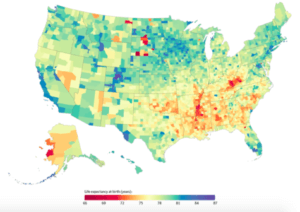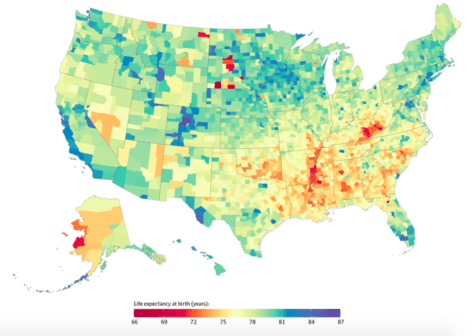SEATTLE — How long you live is in large part predicated on where you live, a new study finds.
Researchers at the University of Washington looked at records from every county in the U.S. between the years of 1980 and 2004, hoping to find extant gaps in life expectancy.
While experts have long known that longevity varies, “what we found is that the gap is enormous,” lead researcher Christopher Murray told WFDD.

Murray and his team found that in 2014, the gap in life expectancy between the counties with the highest and lowest life spans was 20.1 years.
“Several counties in South and North Dakota (typically those with Native American reservations) had the lowest life expectancy, and counties along the lower half of the Mississippi and in eastern Kentucky and southwestern West Virginia also had very low life expectancy compared with the rest of the country. In contrast, counties in central Colorado had the highest life expectancies,” the authors write in the study results.
This translated into a life expectancy of about 87 years in counties with the highest average life span, and a life expectancy of about 67 years in counties with the lowest average life span.
The 20-year gap largely parallels life expectancy differences between high-earning and developing nations— e.g., Japan versus India.
The researchers found that well-off and highly-educated communities— such as Summit County, Colo. and Marin County, Calif.— had the longest life expectancy.
Meanwhile, the least wealthy and educated counties, such as ones surrounding the Mississippi River Valley, and within certain regions in the states of Kentucky and Virginia, had the lowest life expectancy.
Unfortunately, the gap between life expectancy at the two opposite ends grew by two years over the period examined, and it shows no signs of abating.
“Next year, we can reliably expect it’ll be even more than 20,” cautions Murray.
While the reasons for this gap are complicated, it is believed that chronic health problems, such as obesity and smoking play a big role.
“Risk factors — obesity, lack of exercise, smoking, hypertension, and diabetes — explained 74% of the variation in longevity,” said Murray in an interview with CNN. “Socioeconomic factors, a combination of poverty, income, education, unemployment, and race, were independently related to 60% of the inequality, and access to and quality of health care explained 27%.”
Other researchers have linked this inequality of longevity to widening economic inequality nationwide.
Overall, the life expectancy for both men and women increased by 5.3 percent to 79.1 years. For men, the age jumped from 70.0 years to 76.7 years, and for women from 77.5 years to 81.5 years.
The study’s findings were published in the journal JAMA Internal Medicine.

Just another study confirming the South is dirt poor and has a lifestyle similar to SubSahara Africa.